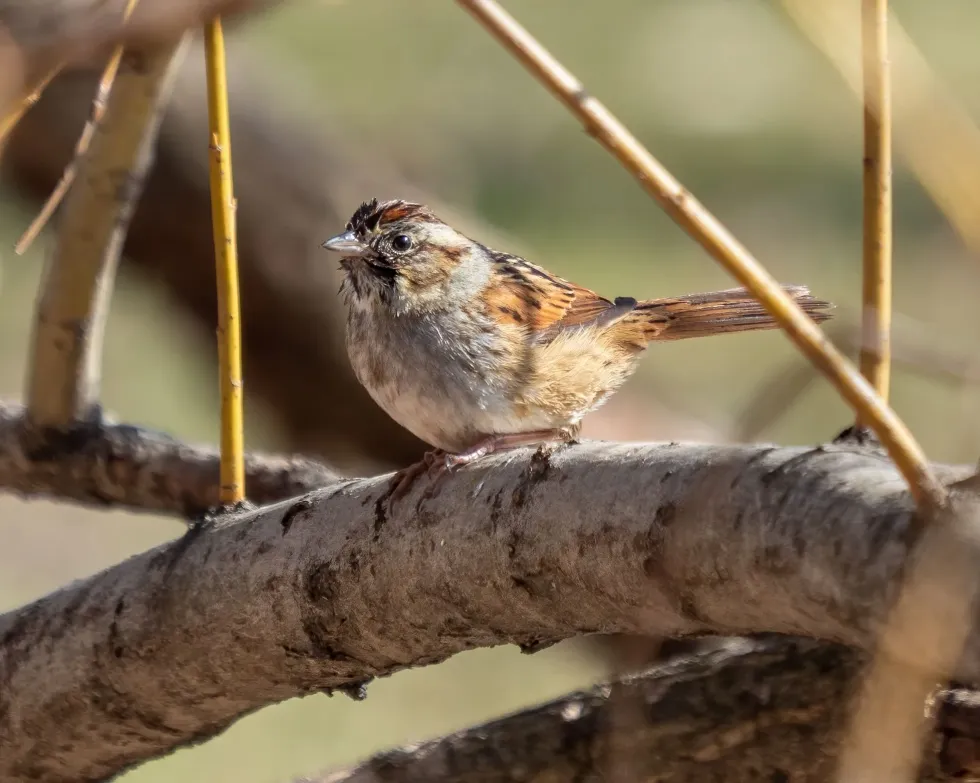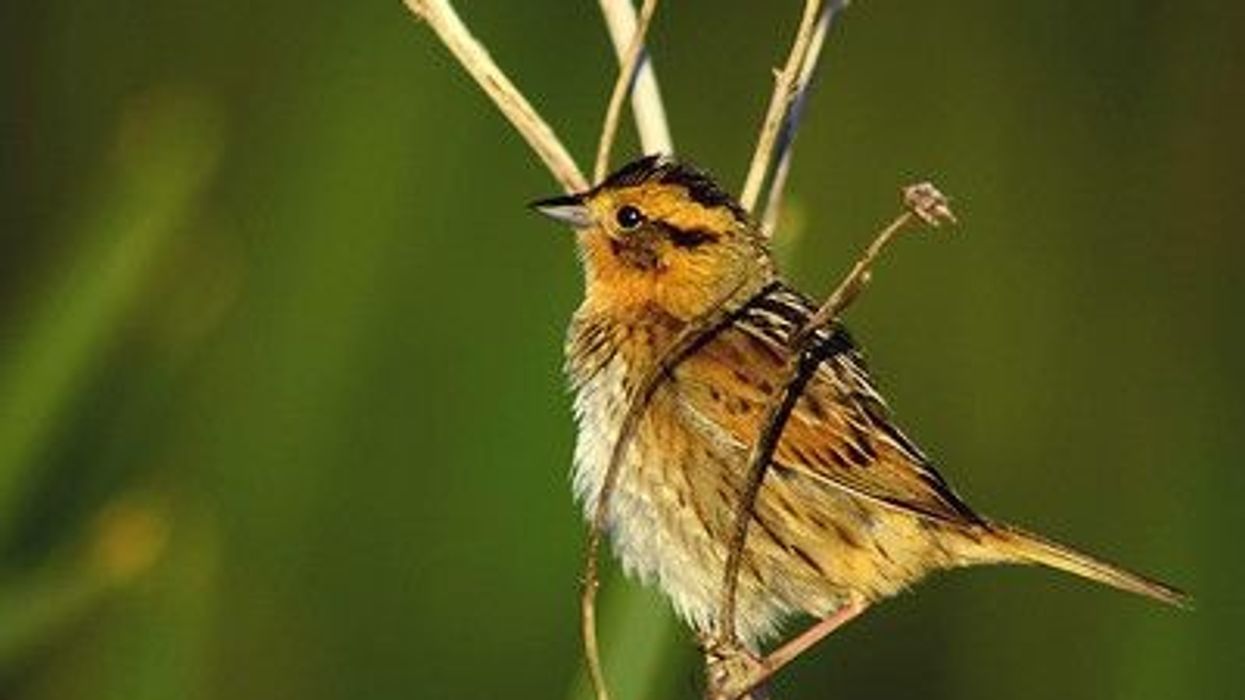The swamp sparrow (Melospiza georgiana) is a small or medium-sized bird species that is primarily a native of North America.
They mainly live near shallow water and in marshes, but move towards weedy fields in winter. They usually prefer to stay alone, except when they migrate in winter or during the breeding season.
The male bird species are territorial.
The birds are found in the eastern U.S. and countries like Canada and are often mixed up with the other genus of their species, the chipping sparrow.
However, swamp sparrows are bigger and bulkier than the chipping sparrow. They have the longest legs of their genus which help them to forage in marshes, looking for food.
To know more facts about swamp sparrows such as swamp sparrow song, swamp sparrow range, swamp sparrow winter, swamp sparrow call, swamp sparrow nest, coastal plain swamp sparrow, juvenile swamp sparrow, immature swamp sparrow, swamp sparrow size, swamp sparrow subspecies, swamp sparrow migration, duck hunting swamp sparrow, swamp sparrow sound, swamp sparrow vs white-throated sparrow, and swamp sparrow vs song sparrow, read the article below.
If you like this article, check out the wandering albatross and the short-eared owl.
Swamp Sparrow Interesting Facts
What type of animal is a swamp sparrow?
A swamp sparrow is a small or medium-sized bird that is mainly found in North America, in U.S., and Canada.
What class of animal does a swamp sparrow belong to?
Swamp sparrows belong to the Aves class of the Animalia kingdom.
How many swamp sparrows are there in the world?
There are around 22 million swamp sparrows around the world according to the American Bird Conservancy.
Where does a swamp sparrow live?
The swamp sparrow lives in various wetlands such as marshes. Most of the species of the bird are sound to reside near freshwater marshes. However, the coastal-plain subspecies are found near tidal wetlands, where seawater and freshwater mix, and the mud is found to be gray instead of brown.
What is a swamp sparrow's habitat?
Swamp sparrows are common in summer in brushy swamps and cattail marshes in the Midwest and Northeast regions of the US, and Canada. During winter, they live away from water bodies, in weedy fields and thickets.
The summer range of the bird concentrates in the eastern half of North American states such as Maryland, Ohio, and Missouri, as well as a large part of Canada that covers Newfoundland to the Rockies. Their winter range includes east American states such as the Gulf Coast, Massachusetts, the southern Great Lakes, Texas, and Florida north to Iowa.
Who do swamp sparrows live with?
The swamp sparrow (Melospiza georgiana) is chiefly a solitary bird except during migration and the breeding season. They join flocks, mostly consisting of birds of other similar species in this season. Other times, they mainly form smaller flocks during the day and large roosting flocks at night.
How long does a swamp sparrow live?
The swamp sparrow has a life expectancy of around seven years.
How do they reproduce?
Like all birds, the swamp sparrows also reproduce by laying eggs. They lay a cluster of one to six spotted bluish-green eggs.
The incubation period usually lasts 12-14 days. The female birds make the nest in dense cover, near the water's edge. Two clutches are laid each year, and if a clutch is destroyed by flooding or predators, another clutch will be laid.
What is their conservation status?
Swamp sparrows are widespread with an extensive global population size. They are preserved by the U.S. Migratory Bird Act. For the last few years, the population of swamp sparrows has been increasing quite stably, and at present, there is no major threat to their population. Hence, their current conservation status is of Least Concern on the IUCN Red List.
Swamp Sparrow Fun Facts
What do swamp sparrows look like?

The swamp sparrow (Melospiza georgiana) is overall quite dark in color. This helps them to camouflage in shadowy or dim habitats. These birds have lighter brown upper bodies, with a splash of brown around the eyes and dark brown wings.
These species of bird have a white throat, grayish breast, and nape. They also have bright, rusty red crowns like the chipping sparrow, but are bigger and bulkier than the latter. These birds have a wingspan of 7.1-7.5 in (18-19 cm).
Both the adult male and female swamp sparrows are quite similar looking and very hard to distinguish. However, the females possess a less extensive rufous crown that is black and more heavily streaked than the males. You can spot these minor differences in mated pairs quite distinctly.
The swamp sparrow fledglings are more buffy with black streaking on the nape, breast, crown, flanks, scapular, neck-sides, and mantles. The streaking on the crown is usually quite heavy, the inside of the mouth is yellow to yellowish-white, and the bill is flesh at first.
However, the white-throated sparrow has a black-and-white-striped head which is augmented by a bright white throat and yellow between the eye and the bill, which is gray. This distinguishes it from a swamp sparrow.
How cute are they?
Swamp sparrows are quite colorful and small-sized birds that look very cute. Particularly, the newly hatched swamp sparrow fledglings are very cute.
How do they communicate?
Swamp sparrows communicate through a series of vocalizations such as singing or calling. The males sing during spring and summer to mark territory and attract mates during the breeding season. Even in some rare moments in early spring, they are heard singing a flight song.
Both the swamp sparrow female and male emit a resonant, sweet, and rich 'seet'. During conflicts, the male swamp sparrows give out buzzy, low-call notes. A series of stuttering chip notes are emitted by the female when flushed from the nest. When separated, pairs emit quiet, sibilant contact calls.
How big is a swamp sparrow?
Swamp sparrows have an average length of 4.7-5.9 in (12-15 cm).
How fast can a swamp sparrow fly?
The exact flight speed of the swamp sparrow is not known.
How much does a swamp sparrow weigh?
The average weight of the swamp sparrow is approximately 0.5-0.8 oz (15-23 g).
What are the male and female names of the species?
There is no specific name for the male and female birds of these species.
What would you call a baby swamp sparrow?
There is no specific name for a swamp sparrow fledgling.
What do they eat?
Swamp sparrows mainly feed on seeds and insects. Their primary diet includes grasshoppers, ants, beetles, crickets, caterpillars, etc. They also eat other arthropods. Being omnivores, these birds also feed on seeds of sedges, grasses, and weeds, especially during winter and fall.
Are they aggressive?
Swamp sparrows are usually not aggressive birds. However, the male swamp sparrow gets aggressive toward other males while establishing territory or during the breeding season. They are also aggressive towards song sparrows but usually refrain from attacking first.
Would they make a good pet?
These North American species of birds tend to live solitary lives near marsh vegetation and are not a great pet choice as they cannot accustom to living in cages in enclosed places. They are birds of the wild and have lower life expectancy when imprisoned in cages.
Did you know...
English physician, John Latham, first described the swamp sparrow in 1790. Latham is remembered as the 'grandfather of Australian ornithology'. As the specimen of this species which he used for his work and description came from the American state of Georgia, the bird was named 'Georgiana.
A swamp sparrow was recaptured and rereleased while banding operations were going on in the state of Maryland. The sparrow was found to be at least seven years and 10 months old. This remains the oldest recorded swamp sparrow to date.
Banding was a popular choice before the development of tracking devices. It was the method that helped clarify migration patterns for many bird species. A swamp sparrow was banded in eastern Massachusetts on 4 October 1937. It was found about 1,125 miles away in Central Florida the following winter in January 1938.
The swamp sparrow is known as Chingolo pantanero in Spanish and Bruant des marais in French.
Swamp sparrow adaptations
These North American species of birds live near marshes or marsh vegetation. They tend to have longer legs than all other members of their genus. This adaptation helps them to wade in shallow water to forage. These birds even sometimes stick their heads underwater to try to capture aquatic invertebrates.
When do swamp sparrows sing?
Swamp sparrows begin singing very early in the day and will sometimes sing through the night, especially when there is moonlight. The male swamp sparrows sing a rich, serene series of notes during summer and spring.
Here at Kidadl, we have carefully created lots of interesting family-friendly animal facts for everyone to discover! Learn more about some other birds including the American wigeon and the killdeer.
You can even occupy yourself at home by drawing one of our swamp sparrow coloring pages.










